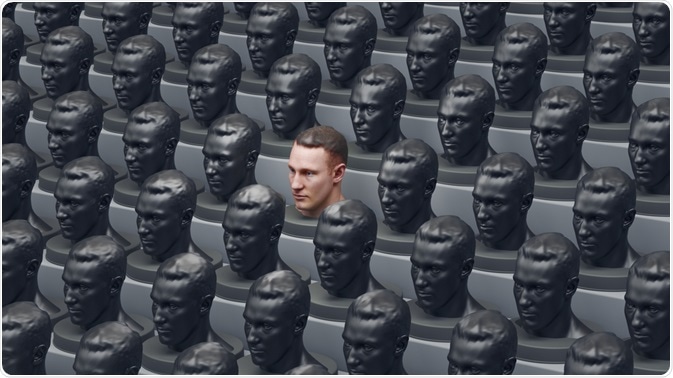Cloning is a process that involves the making of genetically similar copies of a cell or an organism. Clones sometimes occur naturally, for example, bacteria can make exact copies of themselves during their reproduction.

Cloning. Image Credit: ALDECA studio/Shutterstock.com
Even in humans, identical twins are very similar to clones where they share almost exact copies of genes. In biomedical research, cloning is described as the duplication of any biological materials for scientific study. Researchers use polymerase chain reaction (PCR) to make multiple similar copies of a DNA segment or a single cell.
In prokaryotes such as bacteria, which lack prominent nuclei, genetically identical duplicates occur via binary fission and budding. However, for eukaryotes, which possess a prominent nucleus, two types of cellular division take place, namely, mitosis and meiosis. All cells that undergo mitotic division such as skin cells and gastrointestinal tract are clones, whereas, gametes undergo meiosis and result in genetic recombination.
Evolution of Cloning
In 1928, reproductive cloning was first performed by Hans Spemann, a German embryologist, on a salamander embryo. He was later awarded the Nobel Prize for his research on embryonic development, which involved the development of a new cloning procedure known as nuclear transfer.
In 1958 John Bertrand Gurdon, a British biologist, carried out a successful nuclear transfer by using adult intestinal cells’ DNA from African clawed frogs (Xenopus laevis). In 2012, Gurdon was also awarded Nobel Prize in Physiology or Medicine for this breakthrough. The advancement in molecular biology and recombinant DNA technology made it possible for scientists to create transgenic clones.
In early 1980, researchers cloned sheep from partially differentiated embryonic cells. However, in 1996, Ian Wilmut, an English biologist, cloned a sheep named Dolly using nuclear transfer with the help of an enucleated embryo and a differentiated cell nucleus. Researchers have later modified this technique and now it is known as somatic cell nuclear transfer (SCNT).
Recently, researchers have reported the possibility of the DNA of differentiated somatic cells reverting to an undifferentiated embryonic stage. This leads to the reestablishment of pluripotency of the cell. Scientists realized as the DNA of somatic cells could be reprogrammed, they could be effectively used in the study of stem cell therapies and therapeutic cloning.
After Dolly, researchers were successful in cloning several other animals such as pigs, goats, mice, horses, mules, etc., by SCNT. In 2018 researchers reported the successful birth of a viable SCNT primate clone.
Types of Cloning
Cloning is divided into two types based on its function. These are discussed below:
Reproductive Cloning
In reproductive cloning, the cloned embryo is implanted into a real or artificial uterus. The embryo develops into a fetus and grows throughout its term. Reproductive cloning has been practiced for more than 40 years via embryo splitting, which is carried out manually by dividing a single early-staged two-cell embryo into two individual cells and which subsequently grows as two identical embryos.
In summary, this process entails the removal of the entire nucleus from a somatic cell of an organism and insertion of the nucleus into an egg cell (enucleation). After the insertion of the somatic nucleus inside the egg, the egg is stimulated with mild electric current and the cell division initiates. This leads to the creation of a clone.
Reproductive cloning using SCNT is regarded as very harmful because the fetuses of the cloned embryo rarely survive the gestation period and those that survive are born with birth defects. Recently, researchers have been successful in creating a superior breeding bull of Murrah buffalo using SCNT technology.
Therapeutic Cloning
The main purpose of therapeutic cloning is to use cloned embryos to extract stem cells from them, with no intention of implanting the embryos inside a womb. This method enables the study of stem cells that are genetically similar to that of a patient. Stem cells can be stimulated to differentiate into more than 200 cell types in the human body.
Scientists have reported that these differentiated cells could be used to replace the damaged cells without encountering the risk of rejection by the immune system. Stem cells could be used for the treatment of several conditions such as stroke, spinal cord injury, Parkinson's disease, etc.
Are Clones Always Identical?
No, clones are not always identical. Even though clones are genetically identical with one another they might not share similarities in terms of physical characters or behavior. This is because DNA is not the only determining factor of such characters.
Clones could experience different environments and nutrition inside the uterus. Also, the difference in clones occurs if they do not have similar mitochondria. Lastly, the impact of society, life experience, and surroundings also contribute to their development.
Controversies Over Reproductive and Therapeutic Cloning
A group of individuals object to therapeutic cloning because they consider that human life is created and destructed for the betterment of another life. Further, the other group that supports therapeutic cloning highlights the moral ground that these clones could heal the sick and attain greater scientific knowledge.
At present, there are several laws and international conventions which aim to uphold the morals and ethical regulations related to cloning. In 2005, the United Nations approved a nonbinding declaration on human cloning and asked all the member countries “to adopt all measures necessary to prohibit all forms of human cloning since they are incompatible with human dignity and the protection of human life.” However, human embryos can be cloned for legitimate therapeutic and research purposes.
Sources:
- Rugnetta, M. (2020). Cloning. Encyclopedia Britannica. [Online] Available at: https://www.britannica.com/science/cloning
- Selokar, N.L. et al. (2019). Successful cloning of a superior buffalo bull. Scientific Report, 9, 11366. https://doi.org/10.1038/s41598-019-47909-8
- Francisco J. Ayala, J.F. (2015). Genetic therapy and cloning. Proceedings of the National Academy of Sciences, 112 (29), pp. 8879-8886. DOI: 10.1073/pnas.1501798112
- Cloning, definition and application. (2002). Scientific and Medical Aspects of Human Reproductive Cloning. Washington (DC): National Academies Press (US). [Online] Available at: https://www.ncbi.nlm.nih.gov/books/NBK223960/
Further Reading